



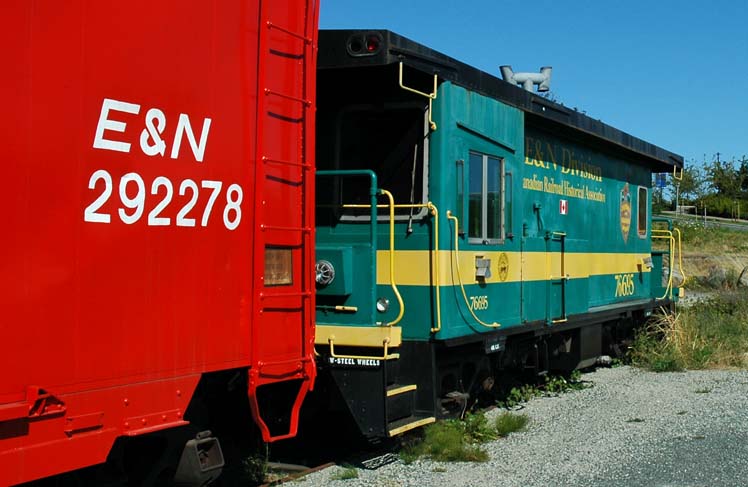
Russell's Roundhouse
Victoria Vancouver Island
British Columbia
N48.4299273
E123.3809347
The Esquimalt & Nanaimo Railway (E&N) was, and currently still is as of 2017, a standard gauge rail line constructed on Vancouver Island, British Columbia, during the late 1880's. Although it has prospered, declined, and been absorbed by other railways over the years it is still fondly called the E&N by locals.
In the beginning Victoria was just a small British colony on the southern tip of Vancouver Island. As the economic times demanded, the British colonies in upper North America started to see advantage in joining together. This set British Columbia on the path to confederation and the formation of a country we now call Canada. Each colony had their own concerns and agenda. British Columbia, which included Vancouver Island, was separated from the East by a "sea of mountains" so a transportation link with the other colonies was imperative. This requirement was specifically written into the terms for joining confederation and the Dominion of Canada.
In 1875 the Dominion Government stated that Esquimalt, on Vancouver Island, was to be the terminus of a proposed railway link to British Columbia. The BC Legislature passed an act, the Esquimalt and Nanaimo Railway Act, giving public land to the Federal government for the construction of the railway from Nanaimo to Esquimalt Harbour. However, although the bill passed Parliament, it was rejected by the Senate. The people of British Columbia were furious and threatened to secede from confederation.
The following year the Governor General, Lord Dufferin , on a mission of diplomacy calmed the turbulent political waters of BC. He was successful in reducing talk of secession from Canada for a time. He was, however, unable to change the status quo. Shortly after, Sir John A. Macdonald
, on a mission of diplomacy calmed the turbulent political waters of BC. He was successful in reducing talk of secession from Canada for a time. He was, however, unable to change the status quo. Shortly after, Sir John A. Macdonald was elected as a Member of Parliament for Victoria in a by-election, and his party came to power in Ottawa. Still, nothing changed, and BC called on the British Imperial government for assistance. British Columbia's desires reached their lowest point in 1882 with the repeal of the E&N Railway Act of 1875.
was elected as a Member of Parliament for Victoria in a by-election, and his party came to power in Ottawa. Still, nothing changed, and BC called on the British Imperial government for assistance. British Columbia's desires reached their lowest point in 1882 with the repeal of the E&N Railway Act of 1875.
By 1884 Sir John had found someone to construct a railway on Vancouver Island, Robert Dunsmuir . Dunsmuir, born into a coal mining family at Riccarton, Scotland, served an apprenticeship under his uncle. He married in 1847 and became an indentured coal miner for the Hudson's Bay Company when he moved his family to Vancouver Island. In 1869 he discovered the rich coal
. Dunsmuir, born into a coal mining family at Riccarton, Scotland, served an apprenticeship under his uncle. He married in 1847 and became an indentured coal miner for the Hudson's Bay Company when he moved his family to Vancouver Island. In 1869 he discovered the rich coal seam at Wellington and formed a company to exploit the resource eventually becoming one of the wealthiest men in Western Canada constructing Craigdarroch Castle
seam at Wellington and formed a company to exploit the resource eventually becoming one of the wealthiest men in Western Canada constructing Craigdarroch Castle in Victoria. One of his two sons, Alexander
in Victoria. One of his two sons, Alexander , managed the family business in San Francisco where he constructed a mansion named Dunsmuir House
, managed the family business in San Francisco where he constructed a mansion named Dunsmuir House in Oakland. It's rumored that a town in northern California
in Oakland. It's rumored that a town in northern California was named after him because he donated a water fountain
was named after him because he donated a water fountain to the town.
to the town.
Construction of the Esquimalt & Nanaimo Railway (E&N) was to be based on the "Dunsmuir Agreement" which gave Dunsmuir a cash grant of $750,000. and 2.1 million acres of land including the mining rights to all minerals. In addition, there was also a grant of 3.5 million acres of land located in the Peace River District of British Columbia. As the newly elected president of the E&N Robert Dunsmuir gave the order to commence construction on 30 Apr 1884.
Originally, the railway connected Nanaimo and Esquimalt, near Plumper Bay. It was estimated it would cost between 3 and 5 million dollars to construct it. Private capital from the company was required. Portions of the line required formidable rock work and the bridging of several canyons.
Nanaimo to Esquimalt construction finished in 1886 with the driving of the last spike on the 13th of August by the Right Honourable Sir John A. Macdonald, first Prime Minister of the Dominion, at Cliffside , near Shawnigan Lake. Shawnigan Lake, about seven miles in length and twenty-seven miles from Victoria, is still skirted by the railway through heavily wooded hills where deer are plentiful. The ceremony also included Lady MacDonald, Robert Dunsmuir, and several guests of the railway president.
, near Shawnigan Lake. Shawnigan Lake, about seven miles in length and twenty-seven miles from Victoria, is still skirted by the railway through heavily wooded hills where deer are plentiful. The ceremony also included Lady MacDonald, Robert Dunsmuir, and several guests of the railway president.
The railway connection between Nanaimo and the station near the Native Village at Plumper Bay was very shortly seen as insufficient. An extension to a station named Russell, near the present day roundhouse at Lime Bay in Victoria West, was complete by 24 Sep 1886.
The citizens of Victoria soon petitioned their City Council demanding the line be extended within city limits. By March, 1888, the tracks had crossed the narrows to the Upper Harbour on a swing bridge  reaching a new station and freight house on Store Street.
reaching a new station and freight house on Store Street.
By June of the next year tracks extended 4.8 miles north from Nanaimo to Wellington, the site of Dunsmuir's coal mine. Dunsmuir's part in the construction of the E&N was done. It was now possible to ride Dunsmuir's railway 77.5 miles from downtown Victoria to Wellington, just north of Nanaimo.
In 1889 Robert Dunsmuir died. His son, James , sold his father's interest in the E&N to the Canadian Pacific Railway (CP) on 7 Jun 1905. CP owned stock in the E&N then leased it, thereby retaining the E&N as a separate company. The line's operations were not integrated into the CP until 1 Jul 1912. At the time the E&N possessed 7 locomotives, five of which were not standard CP design, the other 2 were 4-6-0 D class engines sold to the E&N in 1910.
, sold his father's interest in the E&N to the Canadian Pacific Railway (CP) on 7 Jun 1905. CP owned stock in the E&N then leased it, thereby retaining the E&N as a separate company. The line's operations were not integrated into the CP until 1 Jul 1912. At the time the E&N possessed 7 locomotives, five of which were not standard CP design, the other 2 were 4-6-0 D class engines sold to the E&N in 1910.

Shortly after the sale CP received an additional land grant. 86,000 acres were transferred to the CP/E&N followed by another 20,000 acres in 1910, and still more, another 10,000 acres in 1925.
With these resources CP continued the expansion of the E&N. A branch was run from the main line to Lake Cowichan to collect the timber reserves. A branch to Port Alberni was also constructed.
Track was extended north to Parksville, Qualicum Beach, and finally reached its most northerly extension on Vancouver Island, Courtenay.
For nearly 50 years the CP operated the E&N continually upgrading locomotives and rolling stock to suit the demands of traffic. As the resource industries of Vancouver Island moved into decline so too did the E&N.
and rolling stock to suit the demands of traffic. As the resource industries of Vancouver Island moved into decline so too did the E&N.
As time passed the highways of Vancouver Island improved considerably. People wanted the convenience of their own automobile causing train passengers to soon disappear. The E&N discontinued its passenger service between Nanaimo and Port Alberni in 1953.
By 1962 CP had enough. They requested the Canadian Transport Commission (CTC) permit them to abandon passenger service all over the island. The CTC refused so the remaining E&N passenger service carried on. CP tried again in 1968, 1970, and finally in 1974, the CTC permitted abandonment of passenger service, but not freight, effective 1978.
all over the island. The CTC refused so the remaining E&N passenger service carried on. CP tried again in 1968, 1970, and finally in 1974, the CTC permitted abandonment of passenger service, but not freight, effective 1978.
Vancouver Island was not alone with it's passenger service problems. Discontent was afoot across the country. VIA Rail (VIA) was formed in 1977 by the Federal Government to take over the passenger services of CP and Canadian National Railway (CN). As a result, VIA's Dayliner service started on the E&N, while CP continued to operate a freight only service.
service started on the E&N, while CP continued to operate a freight only service.
The Federal Cabinet, responsible for VIA, announced they intended to cancel Vancouver Island passenger rail service in 1989. The Attorney General of BC refused to accept this and filed suit in BC Supreme Court quoting words from the Dunsmuir Agreement which stated the railway must "continuously and in good faith operate the same". After two years the BC Supreme Court agreed with the Attorney General saying the Federal government had an obligation to keep the rail service operating, but only between Victoria and Nanaimo. A partial victory at least.
Of course, the Federal cabinet disagreed with this decision, and commenced an appeal in the Supreme Court of Canada, one step above the BC Supreme Court. Three years later, on 5 May 1994, the Supreme Court of Canada reversed the lower court's decision. The government was now free to discontinue passenger rail service on Vancouver Island at any time.
About 09:00 on a Monday morning beneath a white tent in Nanaimo's Wellcox railway yard British Columbia Premier Glen Clark shared donuts and coffee with invited guests who were there to hear the E&N Railfreight announcement and watch a newly repainted locomotive
and watch a newly repainted locomotive in E&N Railfreight livery break through a banner stretched across the track. Both Mr. Clark, and Mr. Dodge of CP, gave short speeches to the attendees. Mr. Dodge remarked, "It's a new railway, with a new look." Unfortunately, just 3 years later the so-called "new look" of E&N Railfreight was dead in the water.
in E&N Railfreight livery break through a banner stretched across the track. Both Mr. Clark, and Mr. Dodge of CP, gave short speeches to the attendees. Mr. Dodge remarked, "It's a new railway, with a new look." Unfortunately, just 3 years later the so-called "new look" of E&N Railfreight was dead in the water.
Just prior to the end of Canadian Pacific's operation of the E&N the Six Mile Bridge west of Victoria was replaced by a new modern steel structure on a new track alignment.
west of Victoria was replaced by a new modern steel structure on a new track alignment.
RailAmerica based in Boca Raton, Florida, is an international transportation company that owns or has equity interests in 50 shortline railways operating over approximately 12,400 route miles in the United States, Australia, Canada, and the Republic of Chile. The Company also owns Kalyn/Siebert L.P., and Kalyn/Siebert Canada Inc., specialty truck trailer manufacturers with production facilities in Gatesville, Texas, and Trois-Rivieres, Quebec.

At the time RailAmerica's North American system of railways consisted of 48 shortlines operating approximately 8,000 track miles in twenty-four states and six provinces. Their railways owned or leased approximately 376 locomotives and 4,700 rail cars. Their North American Rail Group served more than 1,100 rail customers and employed approximately 1,700 people.
On 8 Jan 1999 CP and RailAmerica announced a section of the E&N was sold to the newly-formed subsidiary of RailAmerica named the E&N Railway Company (1998) Limited (ENR) . The transaction included the 68 mile section of E&N railway line between Nanaimo and Port Alberni. Trackage from Nanaimo to Victoria, and Parksville to Courtenay, about 113 miles, was leased from CP. Further terms of the transaction were not disclosed at that time but it has since been published they paid CP $15 million for it.
. The transaction included the 68 mile section of E&N railway line between Nanaimo and Port Alberni. Trackage from Nanaimo to Victoria, and Parksville to Courtenay, about 113 miles, was leased from CP. Further terms of the transaction were not disclosed at that time but it has since been published they paid CP $15 million for it.
VIA passenger service on the ENR continued to operate as before. The sale of the E&N section affected 45 employees, who would then work for ENR or remain with CP.
On 15 May 2000 RailAmerica announced an agreement between its subsidiary ENR, and the Pacific Wilderness Railway Company (PAW) . PAW was to bring rail excursion passenger tours to Vancouver Island. With an office in Victoria, the company signed a 10 year operating agreement with ENR to use ENR's rail line for the excursion service.
. PAW was to bring rail excursion passenger tours to Vancouver Island. With an office in Victoria, the company signed a 10 year operating agreement with ENR to use ENR's rail line for the excursion service.
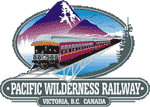
This service commenced 17 Jun 2000 between Victoria and Malahat station located at mile 20
and Malahat station located at mile 20 on the E&N. The PAW operated up to 11 passenger cars capable of carrying 800 passengers on this 2 hour and 15 minute return journey. There were three daily trips until 10 Sep 2000 when weekend-only service was offered until 29 Oct 2000.
on the E&N. The PAW operated up to 11 passenger cars capable of carrying 800 passengers on this 2 hour and 15 minute return journey. There were three daily trips until 10 Sep 2000 when weekend-only service was offered until 29 Oct 2000.
The Chief Executive Officer of PAW was Ross Rowland, a former commodities futures trader, railroad enthusiast, and licensed steam locomotive engineer. Mr. Rowland said this service would be the first stage of a five year plan that he believed would enhance the already strong tourism value in the area. In the upcoming 2001 season, he planned to add a vintage steam engine to the trip.
Suddenly, without warning, on 19 Jul 2001 its locomotives and cars were quickly and quietly withdrawn
its locomotives and cars were quickly and quietly withdrawn from Vancouver Island as PAW ceased operations.
from Vancouver Island as PAW ceased operations.
In November 2001 things really began to come apart for the E&N. Norske Canada, a Port Alberni mill, decided the cost of moving logs by rail between Nanaimo and Port Alberni was 25 percent higher than using trucks so it stopped shipping on the E&N. RailAmerica followed this with an announcement it was shutting down its freight operation effective 1 Jan 2002. Passenger service, also deemed as unsustainable, was slated to end in March. It then commenced to lay off employees leaving only 16 to crew VIA's Dayliner between Victoria and Courtenay.
The approaching loss of the Island's Dayliner galvanized local citizens into bombarding politicians and newspapers with letters to the editor. The SaveRail Coalition was formed to save, preserve, and improve Island service. While the public was so stirred-up the major players involved, and several local companies, came to the rescue of the Dayliner. VIA, CP, Point Hope Shipyard, Superior Propane, and the Cowichan Tribes agreed to pay $150,000 to continue Dayliner service for one month. This first deadline was then set to 15 Apr 2002. Transport Canada later provided another month pushing the deadline to 15 May 2002 saying this was the final bail out.
was formed to save, preserve, and improve Island service. While the public was so stirred-up the major players involved, and several local companies, came to the rescue of the Dayliner. VIA, CP, Point Hope Shipyard, Superior Propane, and the Cowichan Tribes agreed to pay $150,000 to continue Dayliner service for one month. This first deadline was then set to 15 Apr 2002. Transport Canada later provided another month pushing the deadline to 15 May 2002 saying this was the final bail out.
With all the ensuing publicity paying customers stormed the Victoria ticket office for their last chance to ride VIA's Dayliner up-island.
No one noticed the newly refurbished VIA Dayliner that returned to Vancouver Island in August 2002 so it went un-remarked in the press. This was probably missed because of all the excitement over the possible shut-down of the E&N. Its survival was still not secure, as of August 2002, but on a positive note VIA Dayliner 6148 returned to Vancouver Island service.
returned to Vancouver Island service.
With funding provided by RailAmerica and the Vancouver Island Railway Development Initiative (VIRDI) the looming deadline was then postponed until September. During this time negotiations took place between RailAmerica and Tanner Elton representing Superior Propane, Point Hope Shipyards of Victoria, Cowichan Development Corporation of Duncan, and several Island mayors with the intent of purchasing RailAmerica's Vancouver Island assets.
In September 2002 RailAmerica announced it would keep the line running indefinitely. Meanwhile, Elton held several meetings with municipal and First Nation governments, RailAmerica, and CP in an attempt to purchase all CP property on the island. VIRDI also worked to establish a lease agreement with RailAmerica for the use of freight and passenger services.
A company named Vancouver Island Railway Inc. (VIR) was formed with the objective of becoming a full service railway based on a "Community Partnership" Model developed by VIRDI. Their initial investors included: A&B Rail Contractors Ltd, Point Hope Holdings, The Khowutzun Development Corporation, Tanner Elton Ventures, and Woodburn Management. Their target date for commencing operations was Canada Day, 1 Jul 2003.
On 24 May 2003, an article in Victoria's Times Colonist newspaper stated negotiations between VIR and RailAmerica to lease operation of the E&N were suspended. Since VIR had not committed to a deal they lost their "due diligence" deposit. VIR had also intended to purchase land currently owned by CP. RailAmerica's E&N General Manager in Nanaimo stated there was still a possibility negotiations could resume.
On 12 Aug 2003 the Times Colonist reported the Capital Regional District (CRD) is being asked to join other regional districts in a public takeover of the E&N corridor with the intent a privately-owned "Island Rail" would operate the railway. Island Rail says the infrastructure is not adequately maintained and there is about $10 million in outstanding deferred maintenance. The CRD is being asked to approve, in principle, a non-taxable, charitable, Vancouver Island Corridor Foundation (eligible for federal and provincial grants) owned by local governments and First Nations. CP offered to donate its portion of the railroad, including land, rail infrastructure, and related assets to the foundation. That portion of the corridor owned by RailAmerica would be leased to Island Rail with an option to acquire it. Should a future operator fail, then the options would be to find another operator, take over the operation, dissolve the Foundation and dispose of its assets, or use the corridor for other purposes.
Meanwhile, the VIA Dayliner continued to run between Victoria and Courtenay. The question remained... how long would it continue?
continued to run between Victoria and Courtenay. The question remained... how long would it continue?
The Island Corridor Foundation (ICF) is non-profit partnership between the Cowichan Tribes and local governments along the E&N. The ICF came to agreement with CP and RailAmerica to hand over its their rail assets to the foundation for tax credits. In February 2006, CP donated its 145 miles between Victoria and Courtenay to the ICF. The donation tax credit exchange was estimated to be valued at $236 million encompassing six historic railway stations and a number of trestles.

In addition, CP also supplied $2.3 million in seed money to the ICF. Lands were also given that produce non-rail revenue generated by property leases and encroachments on the line. On 22 Mar 2006 RailAmerica donated ownership of the Port Alberni to Nanaimo portion of the E&N to the ICF.
On 1 Jul 2006 the Washington Group's Southern Railway of British Columbia (SRY) took over operations of the E&N for the ICF under the name Southern Railway of Vancouver Island (SVI). By November 2014 SVI freight service along the entire Duncan to Parksville segment of the line was suspended following a risk assessment. Poor upkeep of the track had continuously slowed train speeds. It was unknown when service would resume.
took over operations of the E&N for the ICF under the name Southern Railway of Vancouver Island (SVI). By November 2014 SVI freight service along the entire Duncan to Parksville segment of the line was suspended following a risk assessment. Poor upkeep of the track had continuously slowed train speeds. It was unknown when service would resume.

Beginning 18 Mar 2011 the rail line between Victoria and Courtenay was closed indefinitely and VIA passenger service discontinued due to safety concerns about the poor condition of the track. In April 2012 the Federal Government announced that it would match a $7.5 million grant offered by the provincial government, providing $15 million for basic repairs and upgrades to reopen the rail line. The line was expected to reopen and commence rail service in spring 2013 but was delayed due to failed negotiations between the ICF and VIA. In July 2014 an agreement was signed by VIA to resume operations in the summer of 2015. But in April 2015 the ICF stated that the resumption of service was put on hold because the BC Ministry of Transportation would review the estimated repair costs. It is now the winter 2017 and there has been no VIA Dayliner service for 6 years while the E&N right-of-way continues to deteriorate.
continues to deteriorate.
Canadian Pacific's Esquimalt & Nanaimo Railway roundhouse of 1913 still stands in Victoria West, British Columbia, but portions of the structure continue to deteriorate. This article depicts the current state of the buildings with some recent photographs.
Construction
Robert Dunsmuir's railway, the E&, was complete by August 1886 between Nanaimo and Plumper Bay near Esquimalt. In September 1886 an extension was finished reaching a station named Russell's, near the present day roundhouse located by Lime Bay in Victoria West. (Lime Bay is right below Spinnakers Brew Pub, just off Catherine Street.) In 1905 Canadian Pacific took over the E&N from the Dunsmuir family with a plan to construct a roundhouse near Russell. To this end CP's Division Engineer, R.A. Bainbridge, prepared a construction plan. A contract was awarded to "E.R. Doe and Brother", who then built the roundhouse, machine shop, and boiler houses finishing the work in October 1913.
Between 1913 and 1949 up to 20 steam locomotives were serviced at the Russell's Roundhouse. All that changed in 1949 when the E&N became the first CP division to become fully dieselized. With the steam engines gone diesel-electric units received maintenance at the roundhouse. In 1950 RDCs (Rail Diesel Cars) built by the Budd company, known as Dayliners or Budd cars, began service on the Island. They too received servicing at the roundhouse. VIA Rail Budd cars utilize the only remaining roundhouse stall still available for maintenance. The other stalls are unsafe due to a rotting roof ready to collapse.
were serviced at the Russell's Roundhouse. All that changed in 1949 when the E&N became the first CP division to become fully dieselized. With the steam engines gone diesel-electric units received maintenance at the roundhouse. In 1950 RDCs (Rail Diesel Cars) built by the Budd company, known as Dayliners or Budd cars, began service on the Island. They too received servicing at the roundhouse. VIA Rail Budd cars utilize the only remaining roundhouse stall still available for maintenance. The other stalls are unsafe due to a rotting roof ready to collapse.
1914 Roundhouse Description
In March 1914 a Canadian Railway and Marine World article titled "Esquimalt and Nanaimo Railway Mechanical Terminal Facilities at Victoria, B.C." was published in their periodical. The original turntable mentioned in their article was apparently 70 feet in diameter, but was later replaced by an 85 foot turntable.
article titled "Esquimalt and Nanaimo Railway Mechanical Terminal Facilities at Victoria, B.C." was published in their periodical. The original turntable mentioned in their article was apparently 70 feet in diameter, but was later replaced by an 85 foot turntable.
The Recent Past
A drawing and a photo taken from the rock outcrop to the west overlooking the roundhouse yard shows little change in the track layout over the years. In the 1952 photo shows a track on the right which has since been paved over with asphalt to accommodate the ex-CP freight house.
taken from the rock outcrop to the west overlooking the roundhouse yard shows little change in the track layout over the years. In the 1952 photo shows a track on the right which has since been paved over with asphalt to accommodate the ex-CP freight house.
By 1975 the sand house and tower were still present. The oil tank had been replaced by a diesel fuel shed just visible to the right of the tower. Behind the sand house stood an open tin-roofed rack containing pipes of various lengths.
and tower were still present. The oil tank had been replaced by a diesel fuel shed just visible to the right of the tower. Behind the sand house stood an open tin-roofed rack containing pipes of various lengths.
On 1 Oct 2000 Russell's Roundhouse was designated a National Historic Site of Canada in a commemoration ceremony . Several guests were invited to speak to the public gathering inside the car shop. Well-known Canadian railway author Robert Turner
. Several guests were invited to speak to the public gathering inside the car shop. Well-known Canadian railway author Robert Turner is shown speaking at the podium. While all this was a grand gesture the government designation did not include funds for maintenance of the structure so the roundhouse continued to deteriorate.
is shown speaking at the podium. While all this was a grand gesture the government designation did not include funds for maintenance of the structure so the roundhouse continued to deteriorate.
Around this time a gentleman named Ross Rowland attempted to run a passenger excursion service between Victoria and milepost 20 just north of Malahat Summit. The service lasted a little over a year then folded. His equipment , loaned from the Ohio Central Railroad and lettered Pacific Wilderness Railway, was maintained in the brick car shop.
, loaned from the Ohio Central Railroad and lettered Pacific Wilderness Railway, was maintained in the brick car shop.
The Roundhouse in 2004
The Russell's Roundhouse yard on 20 Nov 2004 is shown in the photo above taken atop the rock bluff at the west end of the yard. The grass and weeds are readily apparent when compared to the 1952 black and white photograph mentioned earlier.
Moving east towards the roundhouse the old stores building can be seen in this photo. It has been occupied by a local furniture construction company for the past several years.
can be seen in this photo. It has been occupied by a local furniture construction company for the past several years.
Immediately west on the turntable approach track is this concrete basin which appears to be for washing equipment although there is no evidence of any wash rack. The VIA Rail Dayliners aren't particularly clean and are showing their age so one wonders if this is a wash rack.
which appears to be for washing equipment although there is no evidence of any wash rack. The VIA Rail Dayliners aren't particularly clean and are showing their age so one wonders if this is a wash rack.
Moving closer, the door to the only operable roundhouse stall is visible behind Budd car 6140. The office is located in the attachment to the roundhouse to the right behind the dumpster. (Translation: garbage bin, dustbin.)
is visible behind Budd car 6140. The office is located in the attachment to the roundhouse to the right behind the dumpster. (Translation: garbage bin, dustbin.)
This next photograph shows the front of the roundhouse with the posts and door latches used to hold the doors open. Plywood sheets on 2 x 4 foot boards were nailed across all but one door sometime last summer but have recently been removed by persons unknown.
with the posts and door latches used to hold the doors open. Plywood sheets on 2 x 4 foot boards were nailed across all but one door sometime last summer but have recently been removed by persons unknown.
Misspelled warning signs are placed about the building on several sides. Looking north from the corner of the roundhouse the skate board park across Esquimalt Road is visible. The concrete skate board area is covered with unsightly graffiti that in the past has spread across the road to blight the roundhouse and equipment.
are placed about the building on several sides. Looking north from the corner of the roundhouse the skate board park across Esquimalt Road is visible. The concrete skate board area is covered with unsightly graffiti that in the past has spread across the road to blight the roundhouse and equipment.
While VIA Rail's Budd cars were spared, the turntable was not so lucky.
was not so lucky.
The turntable is turned by pressure from an air powered motor . My guess would be air pressure is supplied from the brake system on any locomotive using the table. The turntable rarely moves these days but is still operable.
. My guess would be air pressure is supplied from the brake system on any locomotive using the table. The turntable rarely moves these days but is still operable.
This is the car shop as seen from the southwest. The broken windows have been boarded up with a translucent fibreglass material.
as seen from the southwest. The broken windows have been boarded up with a translucent fibreglass material.
Here are the west entrance doors .
.
There are two tracks inside with the right-hand track having a drop pit for axle and wheel changeout. Once again, air is used to pressurize the jack used to raise and lower wheel sets.
for axle and wheel changeout. Once again, air is used to pressurize the jack used to raise and lower wheel sets.
The east end of the car shop is clearly visible from the sidewalk along Esquimalt Road.
of the car shop is clearly visible from the sidewalk along Esquimalt Road.
Looking southeast the back wall of the roundhouse can be seen from Esquimalt Road. Windows have been boarded up with particle board and recently re-painted a dark maroon colour. Graffiti is not present at this time but will no doubt re-appear in the future.
of the roundhouse can be seen from Esquimalt Road. Windows have been boarded up with particle board and recently re-painted a dark maroon colour. Graffiti is not present at this time but will no doubt re-appear in the future.
This photo shows the portion of the building stuck in the corner between the roundhouse and the old machine shop and although it is labelled Locomotive Shop it's really the old boilerhouse . The difference in the roofing material is plainly visible. The roof over the machine shop has been replaced and is in good condition while the loco shop roof, and particularly the roundhouse roof, are in poor condition.
. The difference in the roofing material is plainly visible. The roof over the machine shop has been replaced and is in good condition while the loco shop roof, and particularly the roundhouse roof, are in poor condition.
Looking west , the machine shop north wall, boiler shop, and roundhouse are seen from Esquimalt Road.
, the machine shop north wall, boiler shop, and roundhouse are seen from Esquimalt Road.
The end wall of the machine shop is obscured by trees but you can still see the south wall. The hill to the east of the complex has been turned into a park but still offers a good overall view of the east end of the yard
is obscured by trees but you can still see the south wall. The hill to the east of the complex has been turned into a park but still offers a good overall view of the east end of the yard . Notice the partially covered loading ramp to the left.
. Notice the partially covered loading ramp to the left.
In this close-up you can just make out where some homeless persons have attached blankets to create a shelter beneath the platform. A shabby couch, double-sized bed, and tent are located underneath.
you can just make out where some homeless persons have attached blankets to create a shelter beneath the platform. A shabby couch, double-sized bed, and tent are located underneath.
The Canadian Railroad Historical Association's ex-CN transfer caboose rests on the track next to the loading ramp. Some of its windows have been boarded up due to vandalism.
rests on the track next to the loading ramp. Some of its windows have been boarded up due to vandalism.
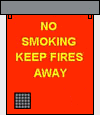
A bright red storage shed for flammable's located next to the turntable for many years has now collapsed in ruins. It looked much better back in 1997
for flammable's located next to the turntable for many years has now collapsed in ruins. It looked much better back in 1997 . Manufactured from plywood the measurements show it to be very small in size.
. Manufactured from plywood the measurements show it to be very small in size.
Lastly, this car stop seems to sum up the fate of this facility. Without funds to purchase the roundhouse from Canadian Pacific and restore the historic buildings the fate of the complex is seriously in doubt. In the meantime it rusts and rots away, neglected by many, except for the few trying to save it.
seems to sum up the fate of this facility. Without funds to purchase the roundhouse from Canadian Pacific and restore the historic buildings the fate of the complex is seriously in doubt. In the meantime it rusts and rots away, neglected by many, except for the few trying to save it.
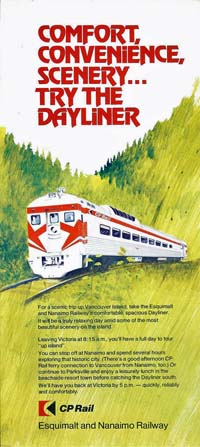
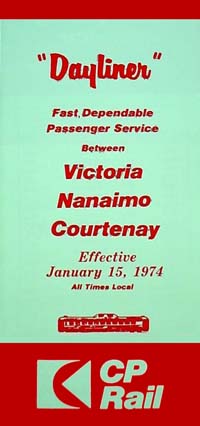
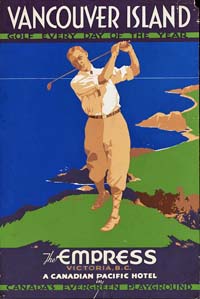
21 Mar 2006 - Vancouver Island Rail Deal Announced
27 Oct 2010 - News About the Esquimalt & Nanaimo Railway
9 Mar 2011 - City of Victoria Abandons Johnson Street Bridge Rail Plan
25 Mar 2011 - Station Renovation Builds Steam
28 Jun 2011 - Premier Clark Announces Funding for E&N
4 May 2012 - Ladysmith Railway Station
22 Jul 2013 - Repairs Approved for Courtenay Train Station Roof
22 Oct 2013 - Restoration of Courtenay's Century Old Train Station Underway
2 Apr 2014 - No Vancouver Island Railway Deal Yet Says VIA Rail
24 Mar 2016 - A Detailed Look at the State of Vancouver Island Rail Service
10 Apr 2016 - The E&N's Long Journey from Dream to Doubt
10 Mar 2017 - Vancouver Island Commuter Rail Study
3 May 2017 - ICF Still Waiting on Federal Grant for Track Repairs
21 Nov 2017 - ICF Meeting with Minister of Transportation and Infrastructure
30 Nov 2017 - E&N Punching Bag Takes More Hits
2 Dec 2017 - Economics Show E&N Rail Line is a Lost Cause
29 Mar 2018 - 16 Fun Facts About the History of the Johnson Street Bridge
1 Apr 2018 - Provincial Government Releases E&N Grant Funds (April Fools)
CRHA E&N Division
Vancouver Island Transportation Corridor Coalition (server returns an invalid response)
Southern Railway of Vancouver Island
Raeside Cartoons




William Slim - 25 October 2020.